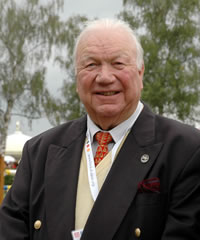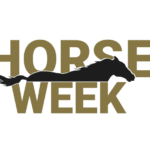
Gladstone, N.J., June 19, 2006 — Going into the U.S. Equestrian Federation’s National Grand Prix Dressage Championship, Steffen Peters and Floriano seemed the likely winners, for their consistency as much as their style.
And win they did, but what made it exciting was the way they did it–with spectacular performances, one right after another in the Grand Prix, the Special and the freestyle, that paid off in unexpectedly big numbers from the judges.
Steffen, who sat chilly while competing (even in yesterday’s mid-90-degree heat) showed his emotional side after his victories, freely admitting to tears of joy when he saw his marks for the Special–77.240 percent, as all five judges placed him first by a mile. That topped his 74.500 percent Grand Prix, which he felt was “as good as it gets” for the 16-year-old Floriano. The 16-year-old chestnut Westphalian showed he had plenty left by rearing excitedly during the awards ceremonies.
But Floriano really proved he had something else up his equine sleeve by nailing an intricately choreographed freestyle, leaving no room to make up any mistakes, since every second was accounted for. Steffen was superb, seemingly drawing out his horse’s energy by osmosis, never making a big move that would distract from Floriano’s performance.
The result was an 83.250 percent freestyle mark that put him over the top.
“It was just one of those rides that you don’t have too many times in your life, where everything was so expressive and so clean,” he said.
“Nobody ever camped on Mt. Everest, but in the meantime, I’m going to enjoy the view,” Steffen observed with a satisfied smile.

His performance was good news for coach Klaus Balkenhol and everyone else concerned about how the U.S. team will do at the World Equestrian Games (WEG) in Aachen, Germany, this August, since the Collecting Gaits Farm/U.S. Equestrian Federation Championships, presented by Paul Miller, were the selection trial for the squad.
“We have no need to hide ourselves,” Klaus said, noting he was encouraged by what he saw at the U.S. Equestrian Federation Foundation’s Dressage Festival of Champions.
The championship, however, was as remarkable for the horses who didn’t make it to Gladstone as it was for the ones who actually competed.
Kingston, fifth in the World Cup finals last year, is in Germany recovering from a strained tendon, which meant rider Leslie Morse had to rely on her less-experienced mount Tip Top. He showed real flair throughout the show, finishing second in the freestyle on an impressive 79.100 percent and barely falling behind Guenter Seidel and Aragon to finish third in the overall standings.
The mare Rocher, who won the freestyle during Dressage at Devon a record three times, isn’t coming back from an injury until next season, according to rider George Williams.
Kennedy, part of the 2004 Olympic bronze medal team and fourth in last year’s World Cup finals, got hurt on the longe line and may not come back at all, said former rider Robert Dover, who trained the horse’s new rider, Katherine Bateson-Chandler. Robert noted the gelding–who was also on the Danish Olympic team–doesn’t owe anybody anything, which I took to mean that it may be retirement time for the 18-year-old horse (though Robert wouldn’t actually commit).

Neruda, who earlier this month stood fourth on the list of prospective competitors who were sound enough to make the championship, was not able to compete because he fell just fractions short of the requirement that he receive a 64 percent score from a foreign O-rated judge.
Michael Barisone, Neruda’s rider and part-owner, tried desperately to find an alternative way he could meet the criteria for competing. Some criticized Michael for not getting the job done between January 1, 2005, and now, but he told me it was a tricky business to get the horse to peak at the right times, and various other problems–including trouble with Neruda’s back at the time of the national freestyle championship in March–had conspired against him.
Officials did tell me that it seemed wrong for a foreign judge to be able to keep someone from trying out for the U.S. team, and I suspect a rule change may be in order. Meanwhile, Michael suggested that both the high and low scores for each movement should be dropped to achieve an average that wouldn’t be skewed.
Anyway, the U.S. ranks are quite thin at this point. Guenter’s runner-up status in the championships was achieved with 73.394 percent to Steffen’s 77.209. But Guenter, who had been neck-and-neck with Steffen earlier in the season in California, barely stayed ahead of Leslie and Tip Top, who had 73.232 percent. Tuny Page and the still-developing national freestyle champ Wild One were fourth on 71.722, while Heather Blitz, who fled Louisiana during Hurricane Katrina and settled in Florida, rose to the occasion to finish fifth with 69.214 percent on Arabella.

Aragon, the statuesque gray gelding who often seems to fly above the ground in the canter, was not at his best during the trials. He showed resistance in the piaffes during the freestyle and had a slow start in the Special the previous day. The first- and second-place winners at the trials were guaranteed places on the team, but I suspect Aragon will be closely watched with the hope that he improves over his Festival performance.
The good news for the team is that team candidate Brentina, the horse who should be the most important factor in an American WEG medal quest, was happily relaxing at home in Idaho while her rider, Debbie McDonald, came to New Jersey to present the new Brentina Cup. That award, which went to Elisabeth Austin of Vermont on Olivier, is an attempt to bridge the gap between the Young Riders’ division and the open Grand Prix ranks.
“It’s very hard for these young people to step right into the Grand Prix ring with people like myself, Guenter and Steffen and have any chance of being successful. This is a chance to get their feet wet,” Debbie said.
Debbie applied for a bye from the trials because of her mare’s outstanding record, which includes leading the U.S. to a silver medal at the 2002 WEG. Selectors are deciding this week on whether she should get the bye, along with who the remaining members of the six-horse short list should be. Tip Top and Wild One seem like a lock; my guess is Arabella will get the final nod.
It’s possible the U.S. can pull off a WEG team bronze medal, staying ahead of chief rivals Denmark, Sweden and possibly Spain. There is no chance to repeat the second-place finish America achieved at the last WEG though; Germany and the Netherlands will be fighting it out for gold and silver.
The Intermediare I (I-1) championship also was a sweep, this one going to Michelle Gibson on Lex Barker. Michelle was the 27-year-old star of the U.S. team at the 1996 Olympics, where she led the squad to a bronze medal on Peron. After the Olympics, the stallion’s owners took him away from the heartbroken Gibson, and he died shortly thereafter. Lex has brought Michelle back into the spotlight, and she obviously adores him.

“He’s good in the ring. He has a little bit of spark to him,” she said, noting he has a cute and funny personality, always curious about everything. He lived up to that reputation by sticking his nose into the silver trophy that went with his title, no doubt looking for a well-deserved treat.
That was Lex’s last competition in the I-1 division, according to Michelle. She’ll be schooling him in Grand Prix movements now. But stay tuned. If the U.S. doesn’t win the bronze at the WEG, it will have to mount a serious team for next year’s Pan American Games in order to qualify for the 2008 Olympics. Lex may need to be on that squad.
The Festival included a third sweep, Rebecca Hart on Nordkap, who won all the para-equestrian competitions. The championships drew a great weekend crowd to the U.S. Equestrian Team Foundation’s Gladstone center, which got a real sprucing up for the occasion. The landscaping was lovely, and two new warm-up rings had been set up in the North Field, while the main ring got a badly needed new surface, courtesy of Footings Unlimited.
“Look at the job they have done pulling this place together,” Tuny Page told me. “I’ve never seen Gladstone look prettier. Every time you come around another corner, there’s flowers and shrubs. It’s wonderful,” she enthused.
That’s all from me this time. Next month I’ll be at the final outing for the short-listed U.S. eventing riders to see who makes the trip to Germany, and in August and September I’ll be at the WEG. So be sure to check back on EquiSearch.com for coverage of both events!





